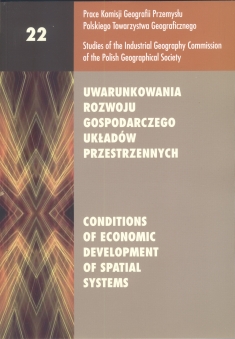Permanent Foreign Immigrations into Poland
DOI:
https://doi.org/10.24917/20801653.22.12Keywords:
immigration, spatial diversity, people covered by the visa movement, foreigners, registered residenceAbstract
In the first years after Poland’s accession to the European Union, the phenomenon of both temporary and permanent emigration from Poland into West and North European countries proved particularly important, as the outflow was quite significant. In the following years, the migratory movement decreased owing to the impact of the world economic crisis, which manifested itself in a smaller number of available jobs, as well as layoffs. The latter were particularly visible in immigration countries, where they mostly affected employees fresh in their jobs - that is, mainly immigrants. What is more, the demand for jobs in foreign markets also decreased, as the majority of the most determined Poles had already moved abroad in the first years after Poland’s accession to the European Union. In contrast, permanent immigration into Poland grew in intensity. This may have been caused the significant share of Poles in the structure of permanent immigration into Poland. The immigrants arriving in Poland for a permanent stay frequently came from the United Kingdom, Germany and Ireland - the main destination countries for Polish post-accession emigrants. The immigrants arriving from the United States and Canada were also numerous, as these countries have a high percentage of inhabitants with Polish ancestors. Some immigrants arrived also from the developing countries, mainly from Vietnam and Ukraine. Finally, repatriations of Poles, mainly from Kazakhstan, played a special role in the phenomenon. The article presents the intensity of permanent foreign immigration into Poland in general. It also outlines the countries that immigrants come from, sorted by selected countries of origin. The immigrants have been classified by their sex, age and marital status. The work also includes an analysis of the spatial diversity of permanent immigrants from abroad by Polish municipality (gminas), in selected years.
Downloads
Metrics
References
Długosz, Z. (2007). Selected Aspects of Foreign Immigration to Poland at the Turn of the 20th/21st Century. Bulletin of Geography, 7, 55–72.
Duszczyk, M., Góra, M. (2012). Active Inclusion of Immigrants in Poland. IZA Discussion Paper, 6427.
Fihel, A., Tyrowicz, J. Kaczmarczyk, P. (2008). Migracje powrotne Polaków. Biuletyn, 5.
Godlewska J. (2010). Migracje i imigranci w Polsce – skala, podstawy prawne, polityka. Ekspertyza przygotowana w ramach projektu EAPN Polska – razem na rzecz Europy Socjalnej. Warszawa.
Grabowska-Lusińska, I. (2010). Poakcesyjne powroty Polaków. CMR Working Papers, 43/101.
Grzymała-Moszczyńska, H., Grzymała-Kazłowska, A. (2011). Repatrianci z Kazachstanu – charakterystyka i główne problemy adaptacyjne. Opracowanie przygotowane na zlecenie Komitetu Badań nad Migracjami Polskiej Akademii Nauk. Warszawa.
Halik, T., Kosowicz, A., Marek, A. (2009). Imigranci w polskim społeczeństwie. Warszawa: Stowarzyszenie Vox Humana.
Iglicka, K. (2009). Powroty Polaków w okresie kryzysu gospodarczego. W pętli pułapki migracyjnej. Raport z badań. Raporty i Analizy, 1.
Kaczmarczyk, P. (2010). Kryzys a decyzje migracyjne Polaków. Biuletyn, 3.
Raźniak, P. (2012). Wpływ poziomu bezpieczeństwa społecznego na migracje ludności w Polsce. Bezpieczeństwo. Teoria i Praktyka, 6(4), 41–52.
Raźniak, P., Winiarczyk-Raźniak, A. (2013). Spatial Distribution and Differences in Migration Patterns and Revenues of Gminas in the Kraków Metropolitan Area. Bulletin of Geography. Socioeconomic Series, 19, 73–86.
Szylko-Skoczny, M., Duszczyk, M. (2010). Polityka imigracyjna Polski – szanse i wyzwania dla rynku pracy. Broszura podsumowująca usługę badawczą. Warszawa: Centrum Rozwoju Zasobów Ludzkich.
Warych-Juras, A., Gałka, J. (2009). Ocena rozmiaru i kierunku napływu obcokrajowców (imigrantów) do polskich miast, w tym ich cech społeczno-demograficznych. W: A. Zborowski, (red.), Demograficzne i społeczne uwarunkowania rewitalizacji miast w Polsce. Kraków: IRM, 61–92.
Weinar, A. (2006). Polityka wobec cudzoziemców w świetle debat parlamentarnych w Polsce, 1990– 2003. Warszawa: Scholar.
Zborowski, A., Raźniak, P. (2013). Suburbanizacja rezydencjonalna w Polsce – ujęcia badawcze i ocena procesu. Studia Miejskie, 9, 37–50.
Downloads
Published
How to Cite
Issue
Section
License
Articles are published under the terms of the Creative Commons License (CC BY-ND 4.0; Attribution– NoDerivs).

